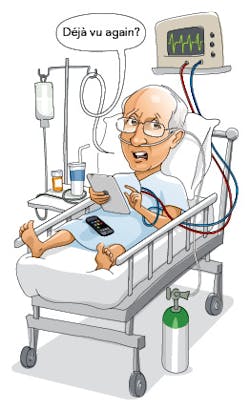Back in 2012, I managed to finalize the November/December issue of this publication while lying in a hospital bed with wires and tubes running all over and around me (see caricature). Seven years later, this happened again as I recovered from a cervical laminectomy and fusion procedure on my upper spine, complicated by wearing a hard neck collar, that limited my flexibility and restricted me from driving.
Like the well-oiled ILS staff has done in the past, another superb issue was produced with customary quality and deployed to global readers on time. Special thanks go to the inimitable Lee Dubay, whose matchless performance as Associate Editor was tested by my unavailability at critical decision points, like a last-minute feature switch, brought about by illness of a contributing author. I am fortunate to have such an efficient and capable editorial partner.
When I planned this issue’s editorial, it was to serve as the first of a two-part series on laser welding, with the second to follow in the July/August 2019 issue. Laser welding, with annual laser revenues of about 13%, has been a technology overwhelmed by the dominance of laser sheet metal cutting (>40% of annual laser revenues) and the sudden appearance of laser additive manufacturing (right now with a modest 5% of total laser revenues, but with unbounded growth opportunities).
Although I gained a reputation in the 1970s introducing laser metal cutting to the U.S., my original goal was to find another high-energy source for cost-effective, technically superior metal joining, building on my early career in electron beam and programmed multi-TIG welding. Lasers now meet and exceed my goals and the major limitation on higher growth rate is the part-specific nature of the process, where rapid industry acceptance is slowed by code qualification issues and user acceptance is almost on a one-for-one basis. As a teaser, let me drop in my candidate as a catalyst to propel laser welding growth—e-mobility.
In this issue, long-time ILS contributor Jack Gabzdyl (SPI Lasers) boldly states that e-mobility represents one of the great predicted mega-trends for the next decade, and he shows good supporting evidence (see page 11). In the same vein, Thibault Bautze (Blackbird Robotersysteme) says that strong market growth in laser welding is observed for all kinds of components related to electric vehicles and lightweight structures—e-mobility again. He introduces a way to improve on-the-fly welding of 2D structures such as batteries for vehicles (see page 15). And Masoud Harooni (TRUMPF Smart Factory) discusses what it takes to use laser welding in production and what the paybacks are. The first section includes discussions about the process, followed by comments on what kind of fixturing investment will be required to make the end user a successful part manufacturer with a focus on the sheet metal industry (see page 19).
On a totally different scale, Giulia Bottarini (FEMTOprint) shows how precision laser microfabrication aids the production of a stunning watch design (see page 22)—a follow-up to a cover story appearing in the March/April 2017 issue. ILS hasn’t looked at laser cleaning for a while and Julien Decloux (Silltec) updates this technology’s use today for the maintenance of tools and most particularly the cleaning of molds (see page 25). And finally, Andreas Thoss (THOSS Media GmbH) and Sebastian Piegert (Siemens’ Gas & Power Business) write about additive manufacturing to enable entirely new design structures for further improvements in turbine efficiency and component durability (see page 28).
About the Author

David Belforte
Contributing Editor
David Belforte (1932-2023) was an internationally recognized authority on industrial laser materials processing and had been actively involved in this technology for more than 50 years. His consulting business, Belforte Associates, served clients interested in advanced manufacturing applications. David held degrees in Chemistry and Production Technology from Northeastern University (Boston, MA). As a researcher, he conducted basic studies in material synthesis for high-temperature applications and held increasingly important positions with companies involved with high-technology materials processing. He co-founded a company that introduced several firsts in advanced welding technology and equipment. David's career in lasers started with the commercialization of the first industrial solid-state laser and a compact CO2 laser for sheet-metal cutting. For several years, he led the development of very high power CO2 lasers for welding and surface treating applications. In addition to consulting, David was the Founder and Editor-in-Chief of Industrial Laser Solutions magazine (1986-2022) and contributed to other laser publications, including Laser Focus World. He retired from Laser Focus World in late June 2022.
